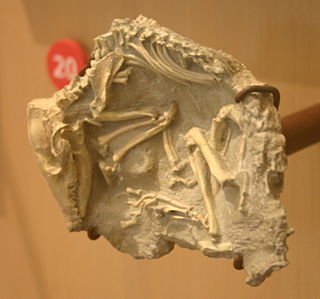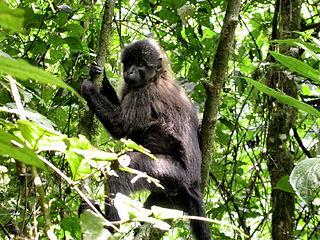
Jackals are medium-sized canids native to Africa and Eurasia. While the word "jackal" has historically been used for many canines of the subtribe canina, in modern use it most commonly refers to three species: the closely related black-backed jackal and side-striped jackal of sub-Saharan Africa, and the golden jackal of south-central Europe and Asia. The African golden wolf was also formerly considered as a jackal.

Characidae, the characids or characins is a family of freshwater subtropical and tropical fish, belonging to the order Characiformes. The name "characins" is the historical one, but scientists today tend to prefer "characids" to reflect their status as a by and large monophyletic group at family rank. To arrive there, this family has undergone much systematic and taxonomic change. Among those fishes that remain in the Characidae for the time being are the tetras, comprising the very similar genera Hemigrammus and Hyphessobrycon, as well as a few related forms such as the cave and neon tetras. Fish of this family are important as food and also include popular aquarium fish species.

The Gruiformes are an order containing a considerable number of living and extinct bird families, with a widespread geographical diversity. Gruiform means "crane-like".

Anseriformes is an order of birds also known as waterfowl that comprises about 180 living species of birds in three families: Anhimidae, Anseranatidae, and Anatidae, the largest family, which includes over 170 species of waterfowl, among them the ducks, geese, and swans. Most modern species in the order are highly adapted for an aquatic existence at the water surface. With the exception of screamers, males have penises, a trait that has been lost in the Neoaves. Due to their aquatic nature, most species are web-footed.

Eutheria is the clade consisting of placental mammals and all therian mammals that are more closely related to placentals than to marsupials.

Felis is a genus of small and medium-sized cat species native to most of Africa and south of 60° latitude in Europe and Asia to Indochina. The genus includes the domestic cat. The smallest Felis species is the black-footed cat with a head and body length from 38 to 42 cm. The largest is the jungle cat with a head and body length from 62 to 76 cm.

Catopuma is a genus of felid containing two small wild cat species, the Asian golden cat and the bay cat. Together with the genus Pardofelis it forms the bay cat lineage of felines. Both are typically reddish brown in colour, with darker markings on the head.

Chevrotains, or mouse-deer, are diminutive, even-toed ungulates that make up the family Tragulidae, and are the only living members of the infraorder Tragulina. The 10 extant species are placed in three genera, but several species also are known only from fossils. The extant species are found in forests in South and Southeast Asia; a single species, the water chevrotain, is found in the rainforests of Central and West Africa. They are solitary, or live in loose groupings or pairs, and feed almost exclusively on plant material. Chevrotains are the smallest hoofed mammals in the world. The Asian species weigh between 0.7 and 8.0 kg, while the African chevrotain is considerably larger, at 7–16 kg (15–35 lb). With an average length of 45 cm (18 in) and an average height of 30 cm (12 in), the Java mouse-deer is the smallest surviving ungulate (hoofed) mammal, as well as the smallest artiodactyl. Despite their common name of "mouse deer", they are not closely related to true deer.

The guenons are Old World monkeys of the genus Cercopithecus. Not all members of this genus have the word "guenon" in their common names; also, because of changes in scientific classification, some monkeys in other genera may have common names that include the word "guenon". Nonetheless, the use of the term guenon for monkeys of this genus is widely accepted.

Balantidium is a genus of ciliates. It contains the parasitic species Balantidium coli, the only known cause of balantidiasis.

Leopardus is a genus comprising eight species of small cats native to the Americas. This genus is considered the oldest branch of a genetic lineage of small cats in the Americas whose common ancestor crossed the Bering land bridge from Asia to North America in the late Miocene.

Acacia, commonly known as the wattles or acacias, is a large genus of shrubs and trees in the subfamily Mimosoideae of the pea family Fabaceae. Initially, it comprised a group of plant species native to Africa and Australasia. The genus name is Neo-Latin, borrowed from the Greek ἀκακία, a term used by Dioscorides for a preparation extracted from the leaves and fruit pods of Vachellia nilotica, the original type of the genus. In his Pinax (1623), Gaspard Bauhin mentioned the Greek ἀκακία from Dioscorides as the origin of the Latin name.

The crested mangabeys are West African Old World monkeys belonging to the genus Lophocebus. They tend to have dark skin, eyelids that match their facial skin, and crests of hair on their heads. Another genus of mangabeys, Cercocebus, was once thought to be very closely related, so much so that all the species were placed in one genus. However, Lophocebus species are now understood to be more closely related to the baboons in genus Papio, while the Cercocebus species are more closely related to the mandrill. In 2006, the highland mangabey was moved from Lophocebus to a new genus, Rungwecebus.

Kinosternoidea is a superfamily of aquatic turtles, which includes two families: Dermatemydidae, and Kinosternidae.

Carnivoramorpha is a clade of placental mammals of clade Pan-Carnivora from mirorder Ferae, that includes the modern order Carnivora and its extinct stem-relatives.

Thalassemys is a genus of extinct thalassochelydian turtle from the Late Jurassic of western and central Europe. While the genus was originally named by Rütimeyer in 1859 for a large carapace and other associated fragments from the late Kimmeridgian of the Reuchenette Formation of Switzerland, although the taxon was not validly named until 1873 when Rütimeyer designated the type species T. hugii. Rütimeyer also named T. gresslyi from the Reunchenette Formation in the same paper as T. hugii, but it cannot be differentiated from the type material of T. hugii and is therefore a junior synonym. A large assemblage of shell and postcranial material from the Reunchenette was named as a species of Eurysternum, E. ignoratum, by Bräm in 1965. While originally distinguished based on the presence of fontanelles on the plastron, the feature was later identified on T. hugii and E. ignoratum was designated a junior synonym. Additional material from the Kimmeridge Clay of the United Kingdom has also been referred to T. hugii.

Carlastyanax aurocaudatus is a small species of freshwater fish in the family Characidae native to the Río Cauca in Colombia. It is the only member of the monotypic genus Carlastyanax, which was named in 1972 specifically for the species by Jacques Géry. Upon description, it was named Astyanax aurocaudatus by Carl H. Eigenmann. There has been debate concerning whether or not the genus should be recognized, but C. aurocaudatus is currently considered a valid species.















